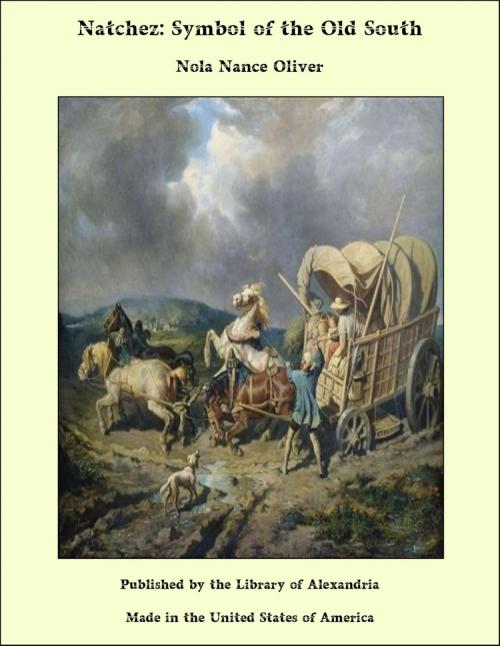Natchez: Symbol of the Old South
Nonfiction, Religion & Spirituality, New Age, History, Fiction & Literature| Author: | Nola Nance Oliver | ISBN: | 9781465613714 |
| Publisher: | Library of Alexandria | Publication: | March 8, 2015 |
| Imprint: | Language: | English |
| Author: | Nola Nance Oliver |
| ISBN: | 9781465613714 |
| Publisher: | Library of Alexandria |
| Publication: | March 8, 2015 |
| Imprint: | |
| Language: | English |
Natchez derives its name from the sun-worshiping Indian tribe, the Natchez, who were the original owners of the area on which the city is located. It is situated in Adams county, in the southwestern part of the state of Mississippi, on bluffs 200 feet high overlooking the Mississippi River, and is midway between Memphis and New Orleans. It is accessible by railway, steamboat, motor highway and airway. It is particularly proud of the Natchez Trace Parkway, a modern concrete road over an old Indian trace or trail from Nashville to Natchez. This highway is a link in one of the most important commercial and historic highways in the United States reaching from Washington, D. C., to Mexico. Today Natchez is a recognized center of interest because in the city and its vicinity there are a greater number of original ante-bellum mansions than in any other community in America—some 75 or more. Natchez is the second oldest town in the United States, being next in age to St. Augustine, Florida. It has lived under five different flags, each of which contributed romantic flavor to the section. From 1714 to 1763 it was under the flag of France; from 1764 to 1780 under the flag of England; and from 1780 to 1798 under the flag of Spain. In 1798 the first United States flag in the Lower Mississippi Valley was raised in Natchez. Years after the raising of the “stars and stripes”, another flag which some call “the conquered banner”, the beloved flag of the Confederate States of America, floated over Natchez, 1861-’65. Natchez “Under the Hill” applies to that part of the town along the water front and under the bluffs. It flourished during the heyday of steamboating on the Mississippi. The inroads of the river have washed away the streets, and only a few buildings remain. One very interesting home, “Magnolia Vale”, has been preserved and is presented in this book. The majority of these old homes contain original pieces of furniture, china, coin silver service, draperies, carpets, wall decorations of exquisite workmanship, huge mirrors in massive goldleaf frames, paintings bearing authentic signatures of great masters, and hand-carved marble mantels. Laces, silks, and rich costumes are displayed today by third, fourth and fifth generations. It seems hardly possible that the world could move on and leave one small community undisturbed in its ancient grandeur. The hand of destiny seems indeed to uphold and enshrine this hallowed region. The estates have descended from generation to generation, many of them today being owned and occupied by descendants of the original owners.
Natchez derives its name from the sun-worshiping Indian tribe, the Natchez, who were the original owners of the area on which the city is located. It is situated in Adams county, in the southwestern part of the state of Mississippi, on bluffs 200 feet high overlooking the Mississippi River, and is midway between Memphis and New Orleans. It is accessible by railway, steamboat, motor highway and airway. It is particularly proud of the Natchez Trace Parkway, a modern concrete road over an old Indian trace or trail from Nashville to Natchez. This highway is a link in one of the most important commercial and historic highways in the United States reaching from Washington, D. C., to Mexico. Today Natchez is a recognized center of interest because in the city and its vicinity there are a greater number of original ante-bellum mansions than in any other community in America—some 75 or more. Natchez is the second oldest town in the United States, being next in age to St. Augustine, Florida. It has lived under five different flags, each of which contributed romantic flavor to the section. From 1714 to 1763 it was under the flag of France; from 1764 to 1780 under the flag of England; and from 1780 to 1798 under the flag of Spain. In 1798 the first United States flag in the Lower Mississippi Valley was raised in Natchez. Years after the raising of the “stars and stripes”, another flag which some call “the conquered banner”, the beloved flag of the Confederate States of America, floated over Natchez, 1861-’65. Natchez “Under the Hill” applies to that part of the town along the water front and under the bluffs. It flourished during the heyday of steamboating on the Mississippi. The inroads of the river have washed away the streets, and only a few buildings remain. One very interesting home, “Magnolia Vale”, has been preserved and is presented in this book. The majority of these old homes contain original pieces of furniture, china, coin silver service, draperies, carpets, wall decorations of exquisite workmanship, huge mirrors in massive goldleaf frames, paintings bearing authentic signatures of great masters, and hand-carved marble mantels. Laces, silks, and rich costumes are displayed today by third, fourth and fifth generations. It seems hardly possible that the world could move on and leave one small community undisturbed in its ancient grandeur. The hand of destiny seems indeed to uphold and enshrine this hallowed region. The estates have descended from generation to generation, many of them today being owned and occupied by descendants of the original owners.















